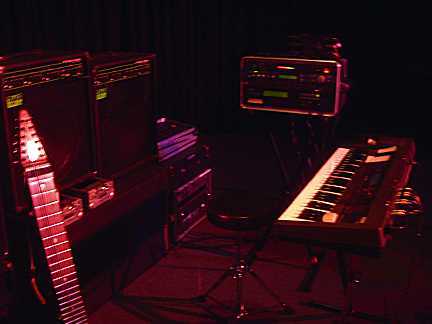|
|
|
TOUR EQUIPMENT:
There have been a lot of questions about what equipment I'll be taking on the road for the Tony Levin tour. Times have sure changed from tours I did years ago carrying Moog modular synthesizers, or even the Fairlight CMI series II. I'll be bringing rather minimal equipment with me, but the capabilities are so great these days that I'm not feeling restricted at all:
- Kurzweil K2000 synthesizer (the one from my studio); full 700k PRAM, 64 meg sample RAM, 500 meg hard drive
- Emu Audity 2000 synthesizer
- Rolls RM-65 mixer
- Alesis Midiverb 4 digital effects unit
- Synergy Systems stage/house sound/subwoofer routing panel
- Furman PL-Plus Power Conditioner
- 2 Trace Elliot TEK150 keyboard amplifiers
- ServoDrive Contrabass subwoofer
- Randall RRM-200 power amplifier

That's really all that there is (Tony's stick is in the left foreground)
I'll also have my "portable studio" with me. This equipment is not part of the stage set, but I will be using it for several writing projects during the months on the road.
- Roland SK-88pro keyboard and synthesizer module
- Mark of the Unicorn FastLane MIDI Interface
- Apple Macintosh "Pismo" PowerBook 2000
- Mark of the Unicorn: Digital Performer
- Opcode: Galaxy Plus Editors
- Bias Peak: Peak
- Waves: plug-ins
- BitHeadz: Retro AS-1, Unity
- Channel D: Mac The Scope
STUDIO EQUIPMENT:
We'll be putting up some pictures and additional information about the Synergy Studio at some point in the future.
In the meantime, there have been a lot of questions about what equipment is used in the Synergy Studio. Briefly, this is what is is currently connected and used to some degree (there is a LOT of stuff retired and in storage):
Instruments:
- Kurzweil K-2000 with sample playback
- Yamaha SY-77
- Korg Wavestation AD
- Emu Audity 2000 synthesizer
- Emu Xtreme Lead 1 (XL-1)Turbo synthesizer
- Emu Proteus 1 XR with Orchestral Module
- Roland D-550
- Roland D-110
- Alesis D4 drum module
- Roland R-8M drum module
- Emu Emulator II
- Sequential Circuits Prophet 5 rev 3
- PAiA Fat Man synthesizer
- Moog Model 15 modular synthesizer (plus additional modules)
- Memorymoog synthesizer
- PAiA midi2cv8 MIDI-control voltage adapter
- PAiA Theremax (theremin-like instrument)
Signal Processing:
- DeltaLab DL2 with memory module
- Lexicon PCM60
- Alesis Quadraverb
- Alesis Microverb
- Alesis Micro Limiter
- Yamaha SPX-90
- Symetrix 511A single-end noise reduction
- PAiA Tube Head preamp
- Hughes SRS sonic imager
- Aphex Type C
- Roland Dimension D SDD-320
Mixers:
- Roland M-160 line mixer
- Roland M-120 line mixer
- Teac Model 2 6 x 4 aux. mixer
- Tascam M-50 12 x 8 monitor mixer
Speakers and Amps:
- JBL 4311B reference monitors
- Intersonics model 215 ServoDrive subwoofer
- McIntosh 2105 monitor amplifier
- McIntosh 250 monitor amplifier
Computers & Interfaces:
- Apple Macintosh G3 (blue & white) 450mHz Yosemite 6 gig drive & 18 gig drive
- Mark of the Unicorn 2408 digital audio interface
- Mark of the Unicorn MIDI Time Piece AV
- Mark of the Unicorn MIDI Time Piece 1
- Power Computing Macintosh Power 120 NuBus 1 gig drive, 6 gig drive
- Digidesign 422 digital interface
- Digidesign ProTools SMPTE Slave Driver
- Apple Macintosh G3 (beige) 266 mHz AV config w/ Orange Micro Pentium card 6 gig, 4 gig drives
- JL Cooper Sync Link
- Yamaha CDE-100 II CD-R burner
- Southworth Jambox 4 MIDI interface
Software:
- Mark of the Unicorn: Digital Performer, AudioDesk
- Opcode: Galaxy Plus Editors, Studio Vision
- Bias Peak: Peak, Deck II
- Digidesign: Sound Designer II, ProTools, MasterList CD
- Waves: most plug-ins that they make
- Adaptec: Toast
- BitHeadz: Retro AS-1, Unity
- Channel D: Mac The Scope
Recording Machines:
- Panasonic SV-3900 DAT w/ SH-MK390 remote
- MCI JH-110/8 analog multitrack
- Pioneer RT-1050 1/2 track analog recorder
- dbx/Teac noise reduction (8 channels)
- dbx Model 180 noise reduction (2 channels)
- Sony WM-D6 Pro cassette recorder
- Sony D5-A CD Player
- Yamaha MT100 II 4 track mini studio cassette recorder
- Sony VP-2011 3/4" Umatic video machine
- JVC HR-S6600U S-VHS video machine
January, 2000
Most recording is now done direct to disk within the computers. The analog recorders are hardly ever switched on, and the DAT only occasionally. The computers can record and play back up to around 32 tracks of digital audio at 16 or 24 bits, and a nearly unlimited number of tracks of MIDI data. Automated mixing is done within the computers, too. Software plug-ins are used for most audio signal processing rather than the aging hardware signal processing boxes listed above. Final output is usually done directly to CD-R as is archival file backup. The old analog mixers are mostly used as monitoring devices since most mixes are actually created digitally with the computer. In the coming years the hardware signal processing, mixing and even synthesizers are likely to be supplanted by all-software systems running inside the computer.
©1999-2001 Synergy® Electronic Music, Inc.
This page was last updated on June 27, 2001
